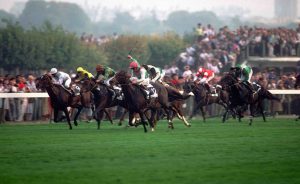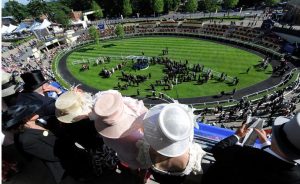In the northern hemisphere, February means the start of another breeding season. The stallion owners have done their marketing, proclaiming and often exaggerating the qualities of their horses, while breeders have made most decisions over how to mate their mares.

Arc hero Dancing Brave (pink cap) was the top-priced sire of 1988
The vendors and buyers of nominations generally have the same objective: they want to make money. Owner-breeders, now very much a minority, may not be motivated by their commercial brethren’s desire – perhaps need – to sell young stock profitably, but even the likes of the Aga Khan and Khalid Abdullah run operations that are intended to pay their way.
Of course, the dice are loaded. The stallion masters may make much of their wish that their clients prosper, but their chief concern has to be that their horses more than repay what has been invested in them. If their stallions prove to be no good, they may still be significant earners before they are ditched.
So while February may seem a time for excitement among ambitious breeders, it’s also a time when they can throw good money after bad and make expensive errors. The potential to get things wrong is now greater than ever, with stallions covering huge books of mares.
We should always try to learn lessons from the past, and one of the facts that history tells us is that more than 90% of stallions turn out to be non-achievers, at best just providing stock who become low-level betting fodder.
So I decided to conduct an examination of what one season’s matings had realised, and 1988 – 30 years ago – seemed to represent a suitable example. Sufficient time has passed for an objective assessment of what the horses at stud in that year had achieved; their careers were now over. And it was possible to make a judgement about the fee charged for their services. I have looked at the 30 British or Irish horses who stood for fees in excess of £15,000.
It was understandable that Reference Point should become one of the most exciting recruits to the ranks of stallions in 1988. He died at seven, leaving nothing of note
The top-priced stallion of 1988 was Dancing Brave (£120,000). He was in his second season at stud, still trading on an exceptional racing reputation. He got nothing of any consequence from that crop, but had such as Commander In Chief, Wemyss Bight and White Muzzle a year later.
By Northern Dancer and out of the dam of Seattle Slew, Lomond (Ir100,000gns) was easily promoted, and he had some early successes. His 1988 matings resulted in one real star in Marling, but the auctioned yearlings averaged under half his fee, and he ultimately mattered little.
An outstanding miler and sire of fillies’ Triple Crown winner Oh So Sharp, Kris (£100,000) was the champion sire of 1985, which earned him respect, but his best work as a sire was already done, and only two Group 3 winners emerged from this crop, and his sons turned out to be poor sires.
We were supposed to believe, on limited evidence, that Shareef Dancer (£100,000) was a top-class racehorse, and his pedigree allowed hopes of success. He did Sheikh Mohammed some favours, but little for anyone else and is rarely encountered in pedigrees now.
Before the 1988 breeding season we knew nothing about Sadler’s Wells (Ir80,000gns) as a sire. But we did know that he had been a racehorse of considerable merit, and that his young stock had sold exceptionally well. He had stood his first two seasons at Ir125,000gns, and the market had been keen. We were soon to learn that he was a sire of enormous consequence.
It was understandable that Reference Point (£70,000) should become one of the most exciting recruits to the ranks of stallions in 1988. He had won the Futurity, the Derby, the King George and the St Leger, proving himself an exceptional athlete. He died at seven, leaving nothing of note.
A far better sire-son of Mill Reef was Shirley Heights (£50,000), but his best contributions, which included a major influence in Darshaan, were now history. Contrastingly, Ahonoora (Ir45,000gns) enjoyed a reputation on the rise, having produced numerous high-quality runners from modest mares off a cheap service fee. The Derby winner Dr Devious was to spring from the 1988 coverings.
Be My Guest (Ir40,000gns) had been champion sire when his first crop were three-year-olds, but the likes of Sadler’s Wells and Caerleon (Ir40,000gns) were now being more strongly promoted by Coolmore. Be My Guest still had Pentire in his future, while Caerleon was about to earn the first of two sires’ titles.
Top Ville (£40,000) had started quite well as a sire in France, but he had little impact after his transfer to England. By contrast, Last Tycoon (Ir35,000gns) was well patronised in Ireland, and buyers liked his early yearlings. He had Marju, Ezzoud and Bigstone among his first three crops, and he became a familiar presence in Australasian pedigrees.
Ajdal (£35,000) died during his first stud season, but is remembered as the broodmare sire of Mark Of Esteem, who was by Darshaan (Ir30,000gns), a potent influence through his runners and even more through the produce of his daughters.
Rousillon is remembered for Vintage Crop and nothing else, proving a disappointment like most other sons of Riverman, while Bellypha features in pedigrees now chiefly as paternal grandsire of Linamix
Law Society (Ir30,000gns) was meant to become an important outcross for all the Northern Dancer horses at Coolmore, but that never materialised, sons of Alleged proving generally disappointing at stud. Runaway Derby hero Slip Anchor (£30,000) had a stamina-laden background, which put many breeders off, but from his 1988 book he got a real star in five-time Group 1 winner User Friendly.
Sure Blade (Ir£30,000) failed, which was the norm for sons of Kris, but Dominion (£25,000), a hardy veteran of 48 races met with some success before fading from pedigrees. If he seemed a tad expensive at the price, that could not be said for two others standing at the same fee. Green Desert had a pedigree profile to excite breeders and, while he lacked consistency at first, he soon established himself as Danzig’s best representative in England and is recognised now as head of a flourishing male line. Rainbow Quest had to be considered a snip at the price and duly developed into an important sire and broodmare sire, if not as a sire of sires.
Rousillon (£25,000) is remembered for Vintage Crop and nothing else, proving a disappointment like most other sons of Riverman, while Bellypha (£20,000) features in pedigrees now chiefly as paternal grandsire of Linamix and the descendants of his daughter Bella Colora.
Sharpo (£20,000) enjoyed some success, generally with sprinters and milers, but was never able to replicate himself, while Don’t Forget Me and Kings Lake (both Ir17,500gns) turned out to be notable non-achievers.
Persian Bold (Ir£17,500) impressed some as a potentially significant agent for the Bold Ruler line in Europe, but the promise was not realised. Still, his son Persian Heights gave us Persian Punch, for which racegoers had to be grateful, and he was a substantially better sire than Wassl (Ir16,000gns), who left nothing worth remembering.
Still commanding respect when he died at 19 in 1988, Classic-winning miler High Top (£16,000) had done well, albeit somewhat surprisingly as sire of middle-distance and staying performers, while Niniski (£16,000) conformed to type, getting accomplished stayers like Petoski, Minster Son, Lomitas and Hernando.
By all accounts there are upwards of 30 new recruits to the 2018 stallion roster in Britain and Ireland, while history tells us that one or perhaps two will actually prove a real success. Not a few of them appear to me to own dubious qualifications for a berth at stud.
Of course, the nomination fees for this year’s 30 most highly priced stallions are on a very different scale from those charged in 1988, but that is not what best illustrates the heightened risk in the 2018 market.
The busiest Flat stallion in these islands 30 years ago was Alzao, whose book numbered 79; all the most popular horses this time around are going to cover more than 100 mares, some over 200.
Invest prudently, if you can. The 2020 yearling sales are going to feature huge numbers of products of every stallion in demand this spring.



